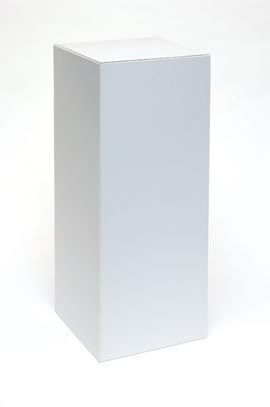
“It all looks like art to me now”. So says Peter Saville and, if his latest exhibition is anything to go by, he’s onto something. For his new exhibition at the Paul Stolper Gallery, Saville has taken a look at the plinth – art’s go-to support-method for props or objects in galleries, museums and studios alike – and turned it's function upside down, metaphorically, at least.
Saville has taken the traditional plinth and recreated it in white cardboard flat-pack, undermining this subconsciously revered object by questioning its status of supposed neutrality. He questions the plinth as an object just as one would question the art it usually supports. He questions whether there is a difference between plinth-as-object and art-as-object. What differentiates a white plinth and the objects we put upon them and label art?
But Saville has done more than reveal the fact that plinths are perhaps no less ‘art-status’-worthy than the things placed upon them. He has invited a series of creative types to display anything they want atop his flat-pack plinths. In addition, he is selling the 96cmx35cmx35cm plinths in an edition of 200, with the first 100 being sold for a clean £50. Not a bad price for the privilege of owning art, one might say. I do wonder, however, what will be done with the creatives’ chosen objects. Are they granted ‘art-status’ by being put up for sale as well? Or are they simply a support to the work, – the Accessories to an Artwork – the plinths? Who would want to buy the artwork’s support-method?
It is an interesting situation, particularly when we consider the names that have been selected to choose an object for the Saville plinths - Wolfgang Tillmans, Cerith Wyn Evans, Brian Eno, Hans Ulrich Obrist, Richard Kern, Jarvis Cocker, Slater Bradley, and Neville Wakefield, among others. One can be sure there will be people interested in buying the prop rather than the work. Or was it the other way around?
Lastly, and with a risk of sounding obtuse, it must be said one is automatically reminded of Antony Gormley’s work for Trafalgar Square’s fourth plinth, One and Other. This jumped to my mind instantly, though others have mentioned Duchamp’s infamous Fountain, which was likewise a seemingly inconsequential object assigned ‘art-status’ simply by the artist deciding to assign it.
The difference, of course, between Gormley and Saville’s works is that Gormley has recruited volunteers to spend an hour each atop the fourth plinth and do what they choose. So the subject is being scrutinised, rather than the object. This subtle difference separates the works greatly. Where Gormley questions the subject’s role in stimulating the viewer to consider "diversity, vulnerability and the individual", Saville’s work ultimately begs the question: what is the value of an object?
Peter Saville: Accessories to an Artwork runs from October 10th to November 22nd, 2008, at the Paul Stolper Gallery, 31 Museum Street, London. For more information visit PaulStolper.com




2 comments:
You might be interested in a piece of work that a group called 'The Hut Project' did in which they responded to a "call for entries". Their response was to manufacture twelve lead ingots that weigh so much that when the work is moved to galleries it is often cheaper to sell the piece for the material value of the lead and manufacture new ingots rather than transport the originals....anyway I'm not making myself very clear, you can have a look for yourself, here is the link. http://www.limoncellogallery.co.uk/pages/thppics.asp
Will I need a plinth to diplay my new plinth? What if I accidently buy a plinth for £50 which is not 'art' but just a normal plinth? Why are scientists being so slow at inventing a display mechanism to allow art pieces to simply float in mid air so that they would not be judged according to the frames they're contained in or plinths they're on?
Post a Comment